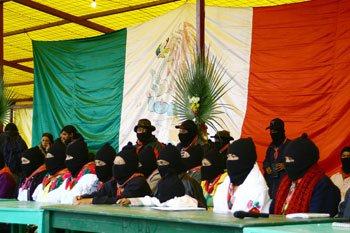


Zapatista Women: “We Are What Holds the Community Together”
A Year After the Passing of Comandanta Ramona, Civilian and Insurgent Women Tell of Their Movement Within a Movement
By Ginna Villarreal
Special to The Narco News Bulletin
January 24, 2007
December 31 2006, Oventic, Chiapas: “As a woman and as an indigenous person I have much to learn and much to teach.” These are the words of Zapatista Comandanta Sandra when she opened the session dedicated to speaking about the struggles of women within the struggle for all people. For Zapatista communities, and other indigenous communities already involved in external struggles, their internal struggles can sometimes be overlooked. On this occasion the people of the world were invited to listen to these women’s stories, their resistances and their triumphs.
 Foto: D.R. 2007 Jesús Domínguez |
Women’s work and women’s presences are often dismissed and devalued. The work of this gathering was, in part, to acknowledge that much of the production and reproduction of the home, family, and therefore of the community is the work of women. ‘We work at the ranch, we work the cafe, the cornfield, the collectives, and the bakeries,” says one.
A letter from the women of the Caracol (the Zapatista term for autonomous municipal seat) of Roberto Barrios details the daily work-day in the communities: “We rise at three or four in the morning, to start the fires to feed the family, to make the coffee for breakfast for our husbands and sons … Later we work the corn to feed the animals. We wake the children and give them breakfast and prepare them for school.”
Washing, cleaning, preparing food, and feeding are all tasks completed before noon. It is only after all have eaten the afternoon meal that the women have a few free moments for themselves to shower, only to come back home to begin to prepare the evening meal. This is the life of a woman from the country of indigenous communities. In the words of one of the women represented by the letter, “we are what hold the community together.”
 Foto: D.R. 2007 Jesús Domínguez |
Like most discussions of women’s position in the EZLN and its civil communities, at this table and at other meetings of the New Year gathering in Oventic, the work and leadership of Comandante Ramona was sited as an illustration of what women can achieve within the movement. She has inspired so many other women: Zapatista, non-zapatista, indigenous and non-indigenous. As one of the movement’s most important figures, this small in stature Tzotsil woman was known and respected throughout the nation and the world before and since her death in January 2006. As an insurgent fighter she lead the battle in which, on December 31, 1993, the Zapatista Army of National Liberation (EZLN, in its Spanish initials) took the city of San Cristóbal de Las Casas. As a diplomat, Ramona was one of the principle drafters for the EZLN’s Women’s Law. She later lead the 1996 delegation to Mexico City for peace talks and co-founded the Indigenous National Congress. The power of this woman and the legacy of her work is felt at meetings such as these, where the cry rallies “viva Ramona, viva.” As a testament to the international appeal of her work, a representative from Kurdistan spoke of a solidarity bridge being built in her name.
 Foto: D.R. 2007 Jesús Domínguez |
For women in these communities the opening of cooperatives has been one of the ways that they have taken to reorganizing for themselves. One of the main sources of income for many families is the artistry of women’s weaving. A quick walk through downtown San Cristóbal and other highland Chiapas towns and one is sure to be flooded by the colors and textures of the textiles produced by women’s hands. For many women the work is done among a multitude of other tasks, and comes from hours of dedication to detail. Though the work is as valuable and beautiful as the culture that makes it, there is much exploitation of women’s labor by charging for piecework or work on contract. These women’s cooperatives have reclaimed the right decided for themselves, the way they work, and the wage they earn for it. The organization is by and for the women. As such new programs following the structure and success of the artist cooperatives have been started with animal, horticulture, and bakeries, and collective stores.
 Foto: D.R. 2006 Jesús Domínguez |
Magdalena and Elena, representatives from the highlands of Chiapas of Caracol II, Oventic, where the gathering was hosted, remind us in their own words that “with this participation by women, we demonstrate our value and our anger at the evil government, and against the injustices…”
Click here for more Narco News coverage of Mexico
Lea Ud. el Artículo en Español
Legga questo articolo in italiano
- The Fund for Authentic Journalism
For more Narco News, click here.




